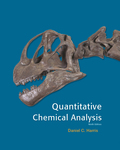
Concept explainers
(a)
Interpretation:
Concept introduction:
The term
(a)
Answer to Problem 11.18P
Explanation of Solution
When
Given data:
Volume and molarity of
Find the equivalence point. At equivalence point,
Therefore volume of
Reaction: 
Initial conc.
Change in conc.
Final conc.
From the standard data of
Determining
(b)
Interpretation:
Concept introduction:
The term
(b)
Answer to Problem 11.18P
Explanation of Solution
When
Given data:
Volume and molarity of
Find the equivalence point. At equivalence point,
Therefore volume of
Determining
(c)
Interpretation:
Concept introduction:
The term
(c)
Answer to Problem 11.18P
Explanation of Solution
When
Known data:
Volume and molarity of
Find the equivalence point. At equivalence point,
Therefore volume of
At equivalence point,
Thus,
Dissociation constant
Solving for ‘x’
Determining
Want to see more full solutions like this?
Chapter 11 Solutions
Quantitative Chemical Analysis
 ChemistryChemistryISBN:9781305957404Author:Steven S. Zumdahl, Susan A. Zumdahl, Donald J. DeCostePublisher:Cengage Learning
ChemistryChemistryISBN:9781305957404Author:Steven S. Zumdahl, Susan A. Zumdahl, Donald J. DeCostePublisher:Cengage Learning ChemistryChemistryISBN:9781259911156Author:Raymond Chang Dr., Jason Overby ProfessorPublisher:McGraw-Hill Education
ChemistryChemistryISBN:9781259911156Author:Raymond Chang Dr., Jason Overby ProfessorPublisher:McGraw-Hill Education Principles of Instrumental AnalysisChemistryISBN:9781305577213Author:Douglas A. Skoog, F. James Holler, Stanley R. CrouchPublisher:Cengage Learning
Principles of Instrumental AnalysisChemistryISBN:9781305577213Author:Douglas A. Skoog, F. James Holler, Stanley R. CrouchPublisher:Cengage Learning Organic ChemistryChemistryISBN:9780078021558Author:Janice Gorzynski Smith Dr.Publisher:McGraw-Hill Education
Organic ChemistryChemistryISBN:9780078021558Author:Janice Gorzynski Smith Dr.Publisher:McGraw-Hill Education Chemistry: Principles and ReactionsChemistryISBN:9781305079373Author:William L. Masterton, Cecile N. HurleyPublisher:Cengage Learning
Chemistry: Principles and ReactionsChemistryISBN:9781305079373Author:William L. Masterton, Cecile N. HurleyPublisher:Cengage Learning Elementary Principles of Chemical Processes, Bind...ChemistryISBN:9781118431221Author:Richard M. Felder, Ronald W. Rousseau, Lisa G. BullardPublisher:WILEY
Elementary Principles of Chemical Processes, Bind...ChemistryISBN:9781118431221Author:Richard M. Felder, Ronald W. Rousseau, Lisa G. BullardPublisher:WILEY





